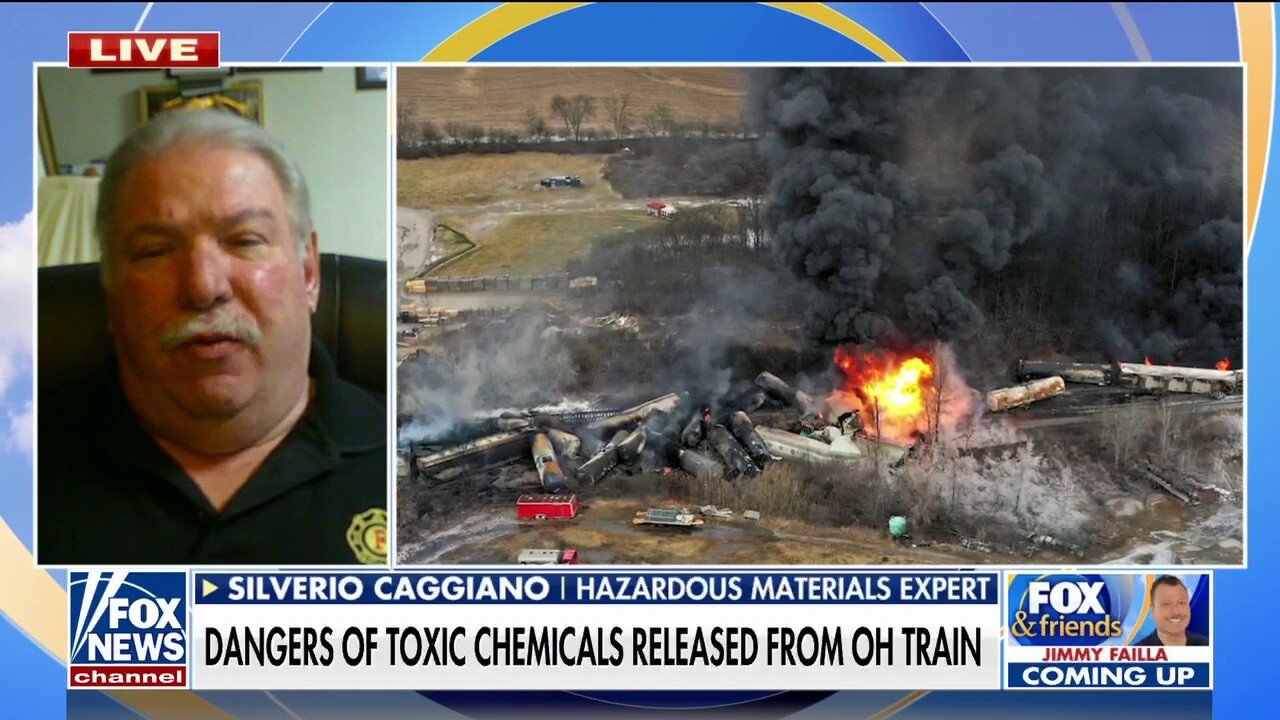Ohio Train Derailment: The Long-Term Impact Of Toxic Chemical Contamination

Table of Contents
Environmental Consequences of the Ohio Train Derailment
The Ohio train derailment resulted in significant environmental contamination, with potentially catastrophic long-term effects.
Soil and Water Contamination
The derailment spilled vast quantities of hazardous chemicals, including vinyl chloride, butyl acrylate, and ethylene glycol monobutyl ether, resulting in widespread soil and water contamination. These chemicals are persistent pollutants, meaning they can remain in the environment for extended periods, posing a continuous threat.
- High levels of vinyl chloride were detected in both soil and water samples near the derailment site.
- Contamination has spread to nearby waterways, impacting aquatic life and potentially contaminating drinking water sources.
- The long-term effects include the potential for lasting damage to ecosystems, reduced biodiversity, and the contamination of agricultural land, rendering it unsuitable for farming.
Air Pollution and its Lasting Effects
The controlled burn of vinyl chloride, undertaken to mitigate the immediate risks, released significant amounts of toxic air pollutants into the atmosphere. This resulted in considerable air quality issues, impacting the health of residents for potentially years to come.
- The burning process released dioxins, furans, and other harmful chemicals.
- Prolonged exposure to these pollutants can lead to respiratory problems, including asthma, bronchitis, and potentially more severe long-term illnesses.
- Ongoing air quality monitoring is crucial to assess the lasting impact of the air pollution and to ensure the safety of the community. Independent studies are also needed to verify government data.
Wildlife Impacts
The release of toxic chemicals has had a devastating impact on local wildlife. Many species are directly exposed to contaminated soil and water or have ingested contaminated food sources.
- Fish kills and bird mortalities have been reported in the areas surrounding the derailment site.
- Long-term studies are necessary to assess the impact on mammals, amphibians, and other wildlife species.
- The potential for long-term ecological damage, including disruption of food webs and biodiversity loss, is substantial.
Long-Term Health Impacts on the Community
The Ohio train derailment poses significant and long-lasting health risks to the community.
Immediate and Delayed Health Effects
Residents near the derailment site reported a range of immediate health effects following the incident. However, the long-term health consequences remain a significant concern.
- Reported immediate health issues included headaches, nausea, vomiting, respiratory irritation, and skin rashes.
- Long-term health concerns include increased risks of cancer, reproductive problems, and neurological disorders due to exposure to vinyl chloride and other toxins.
- Comprehensive long-term health monitoring programs are essential to track the health of residents and identify any delayed health effects.
Psychological Impacts
The Ohio train derailment has caused significant psychological stress and trauma within the affected community.
- Many residents are experiencing anxiety, post-traumatic stress disorder (PTSD), and other mental health challenges.
- Access to mental health services and support is critical for helping individuals cope with the emotional fallout of this disaster.
- Community-based support groups and mental health resources can play a vital role in long-term recovery.
Long-Term Health Studies and Monitoring
To fully understand the long-term health consequences of the Ohio train derailment, comprehensive and independent epidemiological studies are crucial.
- These studies should track the health outcomes of exposed individuals over many years to identify any increased rates of specific diseases.
- Transparency and accessibility of data from these studies are essential for building public trust.
Economic and Social Impacts of the Ohio Train Derailment
Beyond the immediate environmental and health consequences, the Ohio train derailment has caused widespread economic and social disruption.
Economic Losses for Businesses and Individuals
The derailment has resulted in substantial economic losses for businesses and individuals in the affected areas.
- Local businesses, particularly those reliant on agriculture or tourism, have experienced significant revenue losses.
- Property values have declined, and many residents face economic hardship due to job losses and decreased property value.
- The long-term economic recovery will require significant investment and support for affected businesses and individuals.
Social Disruption and Community Response
The Ohio train derailment has created significant social disruption within the community, but it has also fostered a remarkable community response.
- Residents have organized to demand accountability from responsible parties, advocate for stricter regulations, and seek support for their community's recovery.
- Grassroots organizations and community groups are playing a critical role in providing support, information, and resources to those impacted.
- Government response to the crisis has been criticized by many, highlighting the need for improved emergency response protocols and stronger environmental regulations.
Conclusion
The Ohio train derailment presents a stark warning about the devastating consequences of hazardous materials transportation and the urgent need for stronger safety regulations. The long-term impact of this disaster will be felt for decades to come, encompassing environmental devastation, substantial health risks, and significant economic and social disruption. Understanding the aftermath of the Ohio train derailment necessitates ongoing monitoring, support for affected communities, and a commitment to preventing future incidents. Stay informed about ongoing developments, support affected communities through donations or volunteer work, and advocate for stricter regulations to prevent future Ohio train derailment incidents. By working together, we can strive to mitigate the damage and ensure a safer future.

Featured Posts
-
 Segunda Presidencia De Trump Que Espera A Los Deudores De Prestamos Estudiantiles
May 17, 2025
Segunda Presidencia De Trump Que Espera A Los Deudores De Prestamos Estudiantiles
May 17, 2025 -
 The Ultra Wealthy And The Luxury Real Estate Market Navigating Current Chaos
May 17, 2025
The Ultra Wealthy And The Luxury Real Estate Market Navigating Current Chaos
May 17, 2025 -
 Oil Market Overview Key Developments On May 16
May 17, 2025
Oil Market Overview Key Developments On May 16
May 17, 2025 -
 Mlb Mariners Vs Tigers Game Prediction Betting Odds And Analysis
May 17, 2025
Mlb Mariners Vs Tigers Game Prediction Betting Odds And Analysis
May 17, 2025 -
 Kevin Durant Fuels Angel Reese Dating Speculation With Pre Game Remark
May 17, 2025
Kevin Durant Fuels Angel Reese Dating Speculation With Pre Game Remark
May 17, 2025
Latest Posts
-
 3 For 3 Months Of Apple Tv Act Now
May 17, 2025
3 For 3 Months Of Apple Tv Act Now
May 17, 2025 -
 Apple Tv Special Offer 3 Months 3 Ends Soon
May 17, 2025
Apple Tv Special Offer 3 Months 3 Ends Soon
May 17, 2025 -
 Dont Miss Out Apple Tv At 3 For 3 Months
May 17, 2025
Dont Miss Out Apple Tv At 3 For 3 Months
May 17, 2025 -
 Save Big On Apple Tv 3 Months For Only 3
May 17, 2025
Save Big On Apple Tv 3 Months For Only 3
May 17, 2025 -
 Severance How To Watch Every Episode Without Paying
May 17, 2025
Severance How To Watch Every Episode Without Paying
May 17, 2025
